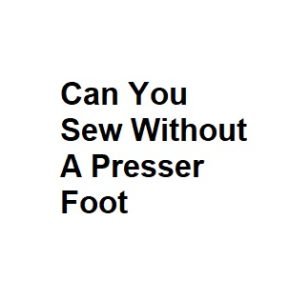Automotive upholstery plays a critical role in enhancing the comfort and aesthetics of a vehicle’s interior. When it comes to sewing automotive upholstery, many individuals wonder if it’s possible to sew without a presser foot. In this article, we will explore the importance of the presser foot in automotive upholstery, the consequences of sewing without it, and potential alternatives.
The Role of the Presser Foot in Sewing:
The presser foot is an integral part of a sewing machine. It serves several essential functions:
- Fabric Control: The presser foot helps to keep the fabric in place while sewing. This prevents shifting or bunching of the material, ensuring even stitching.
- Stitch Quality: It maintains consistent tension on the fabric, resulting in neat and uniform stitches.
- Safety: The presser foot protects your fingers from getting too close to the sewing needle, reducing the risk of injuries.
Sewing Automotive Upholstery Without a Presser Foot:
While it is technically possible to sew automotive upholstery without a presser foot, it is not recommended for several reasons:
- Fabric Control Issues: Without a presser foot, it becomes challenging to control the fabric’s movement. This can lead to uneven stitches, bunching, or misalignment of the material.
- Stitch Quality: The absence of a presser foot can result in inconsistent tension on the fabric, leading to irregular stitches, skipped stitches, or thread bunching.
- Safety Concerns: Sewing without a presser foot increases the risk of accidents as your fingers might come too close to the sewing needle.
Consequences of Sewing Without a Presser Foot:
When sewing automotive upholstery without a presser foot, you may encounter various issues:
- Inconsistent Stitching: Uneven stitching can compromise the appearance and durability of the upholstery.
- Fabric Damage: The lack of proper fabric control can cause the material to fray or tear during sewing.
- Reduced Durability: Weak or irregular stitches can result in upholstery that doesn’t stand up to the rigors of daily use in a vehicle.
Alternatives to Sewing Without a Presser Foot:
If you find yourself in a situation where you cannot use a presser foot for sewing automotive upholstery, consider these alternatives:
- Walking Foot Attachment: A walking foot attachment can help maintain consistent fabric feed and tension, even without a presser foot. It’s particularly useful for handling thick and heavy materials often used in automotive upholstery.
- Adjustable Presser Foot Pressure: Some sewing machines allow you to adjust the presser foot pressure. Reducing the pressure slightly can provide more control over delicate materials.
- Speciazlty Presser Feet: Some sewing machines offer specialty presser feet designed for specific tasks, such as sewing through multiple layers of thick fabric. These feet can improve control and stitch quality.
-
Use a Walking Foot Attachment:
- A walking foot attachment, also known as a dual-feed foot, is a fantastic option for sewing automotive upholstery without a standard presser foot. It has built-in feed dogs that move the fabric from the top, mimicking the action of the feed dogs beneath the fabric. This helps in preventing fabric slippage and ensures consistent stitching.
-
Adjustable Presser Foot Pressure:
- Many modern sewing machines come with adjustable presser foot pressure settings. Experiment with reducing the pressure slightly when sewing delicate automotive upholstery materials. This can provide better control without the need to remove the presser foot entirely.
-
Choose the Right Thread and Needle:
- Selecting the appropriate thread and needle for automotive upholstery is crucial. Heavy-duty upholstery thread and needles designed for thick materials can make a significant difference in stitch quality and durability. Consult your sewing machine’s manual or a professional for guidance on the ideal thread and needle size for your specific project.
-
Practice and Test Sewing:
- Before starting your automotive upholstery project, practice on scraps of the same material to get a feel for sewing without a standard presser foot or with an alternative attachment. Adjust your machine’s settings until you achieve the desired stitch quality and fabric control.
-
Consider Using a Teflon or Roller Presser Foot:
- Teflon or roller presser feet can be useful when working with materials that tend to stick or drag, such as vinyl or leather. These specialty presser feet reduce friction between the fabric and the presser foot, allowing for smoother feeding and preventing material damage.
-
Pay Attention to Stitch Length and Tension:
- Adjusting the stitch length and tension settings on your sewing machine is essential when sewing automotive upholstery. Longer stitches may be necessary for heavy materials, while proper tension ensures the thread doesn’t bunch or break during sewing.
-
Maintain Your Sewing Machine:
- Regular maintenance of your sewing machine, including cleaning, oiling, and ensuring all components are in good working order, is crucial for achieving high-quality automotive upholstery. A well-maintained machine is more likely to handle the demands of heavy materials and intricate stitching.
-
Consider Professional Assistance:
- If you’re uncertain about sewing automotive upholstery without a presser foot or are working on a complex project, it’s wise to consult with a professional upholsterer or automotive upholstery specialist. They can provide expert advice and may have specialized equipment to handle the job efficiently.
Conclusion:
Sewing automotive upholstery without a presser foot is possible but not advisable due to the potential issues it can cause, including uneven stitching, fabric damage, and safety concerns. It is always best to use the appropriate presser foot or explore alternative attachments and settings to ensure the best results when working on automotive upholstery projects. Proper equipment and techniques are essential for achieving high-quality, durable, and safe upholstery for vehicles.
